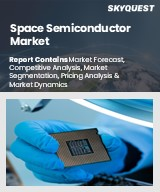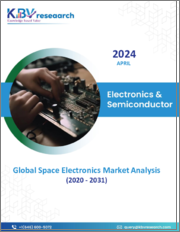
|
시장보고서
상품코드
1496965
우주용 반도체 시장 : 동향, 기회, 경쟁 분석(-2030년)Space Semiconductor Market: Trends, Opportunities and Competitive Analysis to 2030 |
||||||
세계의 우주용 반도체 시장은 2024-2030년의 CAGR이 9.6%로, 2030년에는 추정 21억 달러에 달할 것으로 예상되고 있습니다. 이 시장의 주요 촉진요인은 인공위성, 우주 탐사선, 로켓의 성장, 다양한 분야의 소형 위성 개척, 우주 활동의 제품 개발 기술 발전입니다. 우주용 반도체 시장의 미래는 인공위성, 로켓 및 기타 분야의 기회로 인해 유망합니다.
Texas Instruments, BAE Systems, Cobham, Microsemi, STMicroelectronics, Solid State Devices, T.T.Electronics, Boeing Company, Xilinx 등이 주요 우주용 반도체 제조업체입니다.
Lucintel은 우주용 차세대 반도체의 채택이 증가함에 따라 방사선 경화형 반도체가 가장 큰 부문을 차지할 것으로 예상하고 있습니다. 또한 방사선 경화형 우주용 반도체는 초고온 용도에서 높은 안정성과 효율성을 제공합니다.
아시아태평양은 위성 발사 서비스 프로바이더 증가와 인도, 중국, 일본의 경제 발전으로 인해 예측 기간 중 가장 높은 성장률을 보일 것으로 예상됩니다.
목차
제1장 주요 요약
제2장 시장의 배경과 분류
- 서론, 배경, 분류
- 공급망
- 업계의 촉진요인과 과제
제3장 2018-2030년의 시장 동향과 예측 분석
- 거시경제 동향(2018-2023년)과 예측(2024-2030년)
- 세계의 우주용 반도체 시장의 동향(2018-2023년)과 예측(2024-2030년)
- 플랫폼 유형별 세계의 우주용 반도체 시장
- 위성
- 발사 로켓
- 기타
- 제품 유형별 세계의 우주용 반도체 시장
- 방사선 경화
- 방사선 내성
- 부품 유형별 세계의 우주용 반도체 시장
- 개별 반도체
- 옵토일렉트로닉스
- 집적회로
- 기타
제4장 2018-2030년의 지역별 시장 동향과 예측 분석
- 지역별 우주용 반도체 시장
- 북미의 우주용 반도체 시장
- 유럽의 우주용 반도체 시장
- 아시아태평양의 우주용 반도체 시장
- 기타 지역의 우주용 반도체 시장
제5장 경쟁 분석
- 제품 포트폴리오 분석
- 지역적 범위
- Porter's Five Forces 분석
제6장 성장 기회와 전략 분석
- 성장 기회 분석
- 플랫폼 유형별 세계 우주용 반도체 시장의 성장 기회
- 제품 유형별 세계 우주용 반도체 시장의 성장 기회
- 부품 유형별 세계의 우주용 반도체 시장의 성장 기회
- 지역별 세계의 우주용 반도체 시장의 성장 기회
- 세계의 우주용 반도체 시장의 새로운 동향
- 전략 분석
- 신제품의 개발
- 세계의 우주용 반도체 시장의 생산 능력 확대
- 기술개발
- 세계의 우주용 반도체 산업에서 합병과 인수
제7장 주요 기업의 기업 개요
- Boeing Company
- Texas Instruments
- BAE Systems
- Cobham
- Microsemi
- STMicroelectronics
- Solid State Devices
- T.T. Electronics
- Xilinx
- Others
The future of the space semiconductor market looks promising with opportunities in satellites, launch vehicles, and others. The global space semiconductor market is expected to reach an estimated $2.1 billion by 2030 with a CAGR of 9.6% from 2024 to 2030. The major drivers for this market are growth in satellites, space probes, and launch vehicles; development of small satellites for various sectors; and advancements in technology for product development in space activities.
Texas Instruments, BAE Systems, Cobham, Microsemi, STMicroelectronics, Solid State Devices, T.T.Electronics, Boeing Company, and Xilinx are among the major space semiconductor manufacturers.
A more than 150 page report has been developed to help in your business decisions. Sample figures with some insights are shown below. To learn the scope of, benefits, companies researched, and other details of space semiconductor market report, download the report brochure.
The study includes trends and forecast for the global space semiconductor market by platform type, product type, component type, and region as follows:
By Platform Type [$M shipment analysis for 2018 - 2030]:
- Satellites
- Launch Vehicles
- Others
By Product Type [$M shipment analysis for 2018 - 2030]:
- Radiation-Hardened
- Radiation-Tolerant
By Component Type [$M shipment analysis for 2018 - 2030]:
- Discrete Semiconductors
- Optoelectronics
- Integrated Circuits
- Others
By Region [$M shipment analysis for 2018 - 2030]:
- North America
- United States
- Canada
- Mexico
- Europe
- Germany
- United Kingdom
- France
- Italy
- Asia Pacific
- China
- Japan
- India
- South Korea
- The Rest of the World
Lucintel forecasts that radiation hardened will remain the largest segment due to rising adoption of spaceborne next-generation semiconductors. Moreover, radiation hardened space semiconductors have high stability and efficiency at very high temperature applications.
The APAC region is expected to witness the highest growth in the forecast period due increasing number of satellite launch service providers and economic developments in India, China, and Japan.
Features of Space Semiconductor Market
- Market Size Estimates:Space semiconductor market size estimation in terms of value ($M)
- Trend And Forecast Analysis:Market trends (2018-2023) and forecast (2024-2030) by various segments and regions.
- Segmentation Analysis:Market size by platform type, product type, and component type
- Regional Analysis:Space semiconductor market breakdown by North America, Europe, Asia Pacific, and the Rest of the World
- Growth Opportunities:Analysis of growth opportunities in different platform types, product types, component types, and regions in the space semiconductor market.
- Strategic Analysis:This includes M&A, new product development, and competitive landscape in the space semiconductor market.
- Analysis of competitive intensity of the industry based on Porter's Five Forces model.
This report answers following 11 key questions
- Q.1 What are some of the most promising potential, high-growth opportunities for the global space semiconductor market by platform type (satellites, launch vehicles, and others), product type (radiation-hardened and radiation-tolerant), component type (discrete semiconductors, optoelectronics, integrated circuits, and others), and region (North America, Europe, Asia Pacific, and the Rest of the World)?
- Q.2 Which segments will grow at a faster pace and why?
- Q.3 Which regions will grow at a faster pace and why?
- Q.4 What are the key factors affecting market dynamics? What are the drivers and challenges of the space semiconductor market?
- Q.5 What are the business risks and threats to the space semiconductor market?
- Q.6 What are the emerging trends in this space semiconductor market and the reasons behind them?
- Q.7 What are some changing demands of customers in the space semiconductor market?
- Q.8 What are the new developments in the space semiconductor market? Which companies are leading these developments?
- Q.9 Who are the major players in the space semiconductor market? What strategic initiatives are being implemented by key players for business growth?
- Q.10 What are some of the competitive products and processes in the space semiconductor market, and how big of a threat do they pose for loss of market share via material or product substitution?
- Q.11 What M&A activities did take place in the last five years in the space semiconductor market?
Table of Contents
1. Executive Summary
2. Market Background and Classifications
- 2.1: Introduction, Background, and Classifications
- 2.2: Supply Chain
- 2.3: Industry Drivers and Challenges
3. Market Trends and Forecast Analysis from 2018 to 2030
- 3.1: Macroeconomic Trends (2018-2023) and Forecast (2024-2030)
- 3.2: Global Space Semiconductor Market Trends (2018-2023) and Forecast (2024-2030)
- 3.3: Global Space Semiconductor Market by Platform Type
- 3.3.1: Satellites
- 3.3.2: Launch Vehicles
- 3.3.3: Others
- 3.4: Global Space Semiconductor Market by Product Type
- 3.4.1: Radiation-Hardened
- 3.4.2: Radiation-Tolerant
- 3.5: Global Space Semiconductor Market by Component Type
- 3.5.1: Discrete Semiconductors
- 3.5.2: Optoelectronics
- 3.5.3: Integrated Circuits
- 3.5.4: Others
4. Market Trends and Forecast Analysis by Region from 2018 to 2030
- 4.1: Global Space Semiconductor Market by Region
- 4.2: North American Space Semiconductor Market
- 4.2.1: Market by Platform Type
- 4.2.2: Market by Product Type
- 4.2.3: The US Space Semiconductor Market
- 4.2.4: The Canadian Space Semiconductor Market
- 4.2.5: The Mexican Space Semiconductor Market
- 4.3: European Space Semiconductor Market
- 4.3.1: Market by Platform Type
- 4.3.2: Market by Product Type
- 4.3.3: German Space Semiconductor Market
- 4.3.4: United Kingdom Space Semiconductor Market
- 4.3.5: French Space Semiconductor Market
- 4.3.6: Italian Space Semiconductor Market
- 4.4: APAC Space Semiconductor Market
- 4.4.1: Market by Platform Type
- 4.4.2: Market by Product Type
- 4.4.3: Chinese Space Semiconductor Market
- 4.4.4: Japanese Space Semiconductor Market
- 4.4.5: Indian Space Semiconductor Market
- 4.4.6: South Korean Space Semiconductor Market
- 4.5: ROW Space Semiconductor Market
- 4.5.1: Market by Platform Type
- 4.5.2: Market by Product Type
5. Competitor Analysis
- 5.1: Product Portfolio Analysis
- 5.2: Geographical Reach
- 5.3: Porter's Five Forces Analysis
6. Growth Opportunities and Strategic Analysis
- 6.1: Growth Opportunity Analysis
- 6.1.1: Growth Opportunities for the Global Space Semiconductor Market by Platform Type
- 6.1.2: Growth Opportunities for the Global Space Semiconductor Market by Product Type
- 6.1.3: Growth Opportunities for the Global Space Semiconductor Market by Component Type
- 6.1.4: Growth Opportunities for the Global Space Semiconductor Market by Region
- 6.2: Emerging Trends in the Global Space Semiconductor Market
- 6.3: Strategic Analysis
- 6.3.1: New Product Development
- 6.3.2: Capacity Expansion of the Global Space Semiconductor Market
- 6.3.3: Technology Development
- 6.3.4: Mergers and Acquisitions in the Global Space Semiconductor Industry
7. Company Profiles of Leading Players
- 7.1: Boeing Company
- 7.2: Texas Instruments
- 7.3: BAE Systems
- 7.4: Cobham
- 7.5: Microsemi
- 7.6: STMicroelectronics
- 7.7: Solid State Devices
- 7.8: T.T. Electronics
- 7.9: Xilinx
- 7.10: Others
(주말 및 공휴일 제외)














